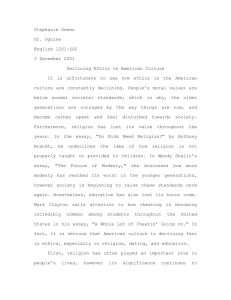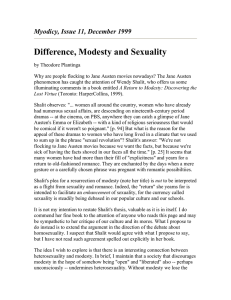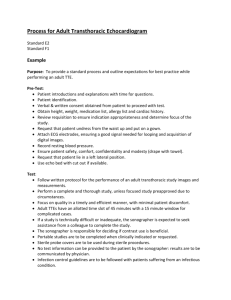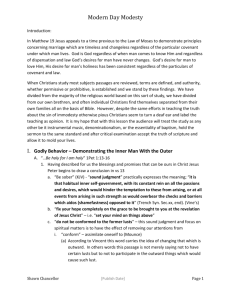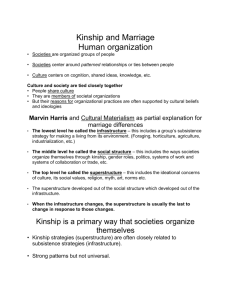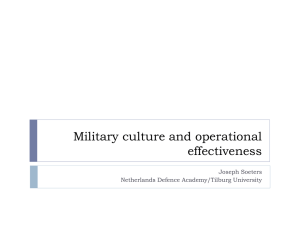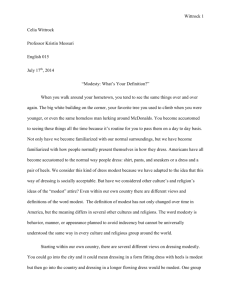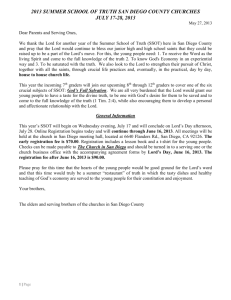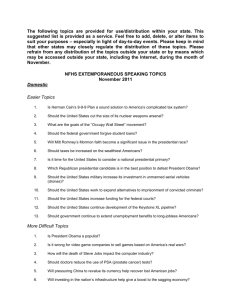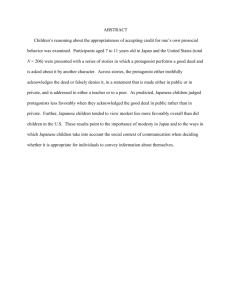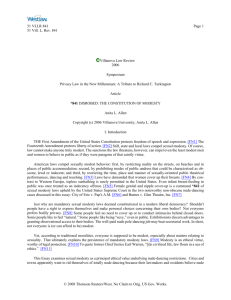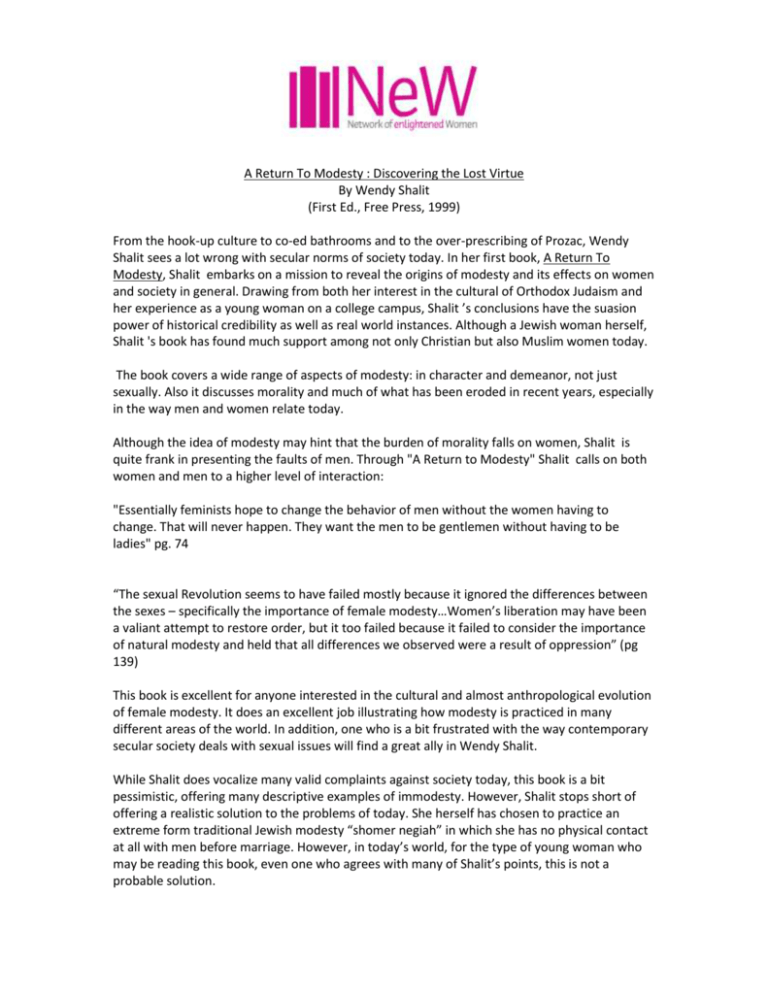
A Return To Modesty : Discovering the Lost Virtue
By Wendy Shalit
(First Ed., Free Press, 1999)
From the hook-up culture to co-ed bathrooms and to the over-prescribing of Prozac, Wendy
Shalit sees a lot wrong with secular norms of society today. In her first book, A Return To
Modesty, Shalit embarks on a mission to reveal the origins of modesty and its effects on women
and society in general. Drawing from both her interest in the cultural of Orthodox Judaism and
her experience as a young woman on a college campus, Shalit ’s conclusions have the suasion
power of historical credibility as well as real world instances. Although a Jewish woman herself,
Shalit 's book has found much support among not only Christian but also Muslim women today.
The book covers a wide range of aspects of modesty: in character and demeanor, not just
sexually. Also it discusses morality and much of what has been eroded in recent years, especially
in the way men and women relate today.
Although the idea of modesty may hint that the burden of morality falls on women, Shalit is
quite frank in presenting the faults of men. Through "A Return to Modesty" Shalit calls on both
women and men to a higher level of interaction:
"Essentially feminists hope to change the behavior of men without the women having to
change. That will never happen. They want the men to be gentlemen without having to be
ladies" pg. 74
“The sexual Revolution seems to have failed mostly because it ignored the differences between
the sexes – specifically the importance of female modesty…Women’s liberation may have been
a valiant attempt to restore order, but it too failed because it failed to consider the importance
of natural modesty and held that all differences we observed were a result of oppression” (pg
139)
This book is excellent for anyone interested in the cultural and almost anthropological evolution
of female modesty. It does an excellent job illustrating how modesty is practiced in many
different areas of the world. In addition, one who is a bit frustrated with the way contemporary
secular society deals with sexual issues will find a great ally in Wendy Shalit.
While Shalit does vocalize many valid complaints against society today, this book is a bit
pessimistic, offering many descriptive examples of immodesty. However, Shalit stops short of
offering a realistic solution to the problems of today. She herself has chosen to practice an
extreme form traditional Jewish modesty “shomer negiah” in which she has no physical contact
at all with men before marriage. However, in today’s world, for the type of young woman who
may be reading this book, even one who agrees with many of Shalit’s points, this is not a
probable solution.
Discussion Guide
Part One The Problem
1. The War on Embarrassment
This chapter covers many of the topics today which evoke embarrassment
many, for example sex-ed in schools.
among
(Note to discussion leader: This is a fairly easy springboard with which to begin discussion.
Everyone has seen evidence of this “War on Embarrassment”. Women will probably want to
share stories about personal experiences. This is a good way to open up the discussion as it will
get everyone interested and involved. In order to guide the discussion pick a few quotes or key
points such as: )
"Today embarrassment is something to "overcome" but maybe if so many girls are still
embarrassed, even in an age when we're not supposed to be, maybe we have our
embarrassment for a reason" pg.21
What are the pros and cons of being embarrassed which the author points out? Is it something
truly to be overcome or could it stem from something real and serve a purpose?
(Note to discussion leader: As previously stated, many of these topics evoke many personal
anecdotes. Be aware that this discussion has some direction and purpose, not simply venting
about the state of today’s society. For example, there can be some excellent debate on the idea
of embarrassment, because it is generally viewed as a negative thing. The fact that Shalit argues
it serves a purpose and may even be a “good” is somewhat contradictory to this preconceived
idea.)
2. Postmodern Sexual Etiquette, from Hook-Up to Check-up
This chapter paints a picture of the "hook-up culture" often seen especially in college campuses
today.
"In the age of the hook-up, young women confess their romantic hopes in hushed tones, as if
harboring some terrible secret...She is torn by the need to be accepted by society" pg. 37
We all have witnessed and even lived the hook up culture which the author portrays first
hand. Is the author correct in her representation of the pressure women feel to "have many
men" (pg. 36) ? In what ways is this pressure beneficial or harmful?
3. The Fallout
The author quotes Tocqueville: "who famously wrote: 'chief cause of the extraordinary
prosperity and growing power of [America] was due to the superiority of their women" (pg. 39)
She goes on in this chapter to argue that instances of pornography and rape are evidence that
this respect for women has declined over the years as the "liberation" of women has increased.
Do you see this as true? Is respect something which must be given up in the pursuit of equality?
4. New Perversions
This chapter covers the effects that this decrease in respect has had on women, via eating
disorders, infidelity etc.
"Essentially, feminists hope to change the behavior of men without having to
change...Conservatives, mostly men...want the women to be ladies while still getting to do
whatever they want" pg. 74-75.
Are all of these problems the author points out equally caused by both sexes? On whom
does it depend to change the norms of society?
Part Two: The Forgotten Ideal
5. Forgiving Modesty
In this chapter Shalit gets into the historical roots of the idea of modesty. She explains
how many cultures have different words for the humility type of modesty and the sexual type of
modesty.
"A culture that respects a specifically female type of modesty is one that regulates and informs
the relation between the sexes in a nuanced…way" pg 97.
What are some her strongest cultural and historical supports for modesty as a virtue? Are they
persuasive in arguing against the idea that modesty 'is a projection of masculine shame" (pg.
97)?
6. The Great Deception
This is a more interesting and somewhat controversial chapter in which the author hits on a
key aspect of the modesty debate: the sexual desire of women
"You either believe that a woman's sex drive is exactly identical to a men's or that a women are
sexless creatures…the reason for modesty is not that women have any less sex drive than men,
but that it is a different kind" pg 113-115
Is the first part of this an accurate assessment of most people's mentality? How relevant to the
broader issues of equality and morality in society is this question? Does her explanation seem to
provide any solutions?
7. Can modesty be Natural?
In this chapter Shalit directs her arguments to those who would believe however historical the
ideas of embarrassment and modesty are purely social institutions, but explaining the biology.
She quotes a magazine for girls
"When you're embarrassed your nerves send extra blood into the tiny vessels in your
skin…Doctors call this vasodilatation. The rest of us call it a blush" pg. 125
Here the ideas of evolutionary psychology are touched on and the debate takes an interesting
turn. Are some aspects of our chemical make-up contributing to/there for our social good?
8. Male Character
This chapter explores the ideas of honor and chivalry in men have disappeared in recent years as
they are considered condescending to women and a remnant of patriarchal control:
"Today forbidden behavior includes candlelit dinners ("prostitution" according to…Alison Jager),
opening a door for women ("sends a clear message that "women are incapable" says
philosopher Marilyn Frye) and gestures such as…giving up one's seat" pg 155
Are these ideas shared throughout women or only in the far radical feminist movements? Is the
loss of "chivalry" really a significant problem in society? What are the good and bad things about
it?
Part Three: The Return
9. Against the Curing of Womanhood
The third part of the book is where Shalit begins to offer a solution for the previously stated
problems facing society. In this chapter she debates the idea that the solution is to do away with
feminine sensitivity with medication.
“ A woman soon learn that all blame for suffering lies within herself, for being too “sensitive.”
She resents this sensitivity of hers, then trivializes It, and finally she acts in such a way as to
constantly negate it” pg. 168
Are there any merits to a woman not indulging her sensitivity? The author paints a quite
negative picture of anti-depressants; is this a reasonable portrayal?
10. Modesty and the Erotic
Chapter 10 correlates the lack of modesty with a numbness to sexuality. She uses examples of
nudist colonies, coed wrestling and classic movies.
“Without modesty, we are lost – not excited by anything much, and not knowing what the
problem is” (pg 180)…”Modesty is proof that morality is sexy” (193).
Whether or not Shalit has been persuasive thus far, is this last claim valid, if so why has it failed
to be hugely effective in changing society?
11. Pining for Interference
This Chapter Shalit advocates as part of her solution the involvement of parents. Not only do
women need to be loved and accepted as they are, as argued in the previous chapter, but just as
all humans, need boundaries and structure:
“Since there will be no ‘interference’ each assumes there is something wrong with her…What’s
truly oppressive to girls is presenting them with a false picture, one without any irregularities or
complications” (210).
Would more parental involvement be a positive influence on the state of young women or does
it contribute to a spirit of rebellion as some argue? Is divorce as black a picture as Shalit paints
it?
12. Beyond Modernity
In this chapter Shalit presents the experiences of a few young women and men who have opted
for more conservative lifestyle there parents. Most of her examples are the testimonies of
Jewish or Muslim women.
“ ‘The Islamic dress code is based on the Islamic belief that sexual urges are a natural and
normal part of the human experience…In order to prevent our natural feelings…from
overpowering our logic and dictating our behavior…both men and women should cover up’”
(218)
How does this belief differ from the Jewish concept of “tzniut”? How does this explanation seem
In light of oppression of women seen in parts of the Muslim world?
A Modest Conclusion: Innocence
In her conclusion Shalit expresses a very simple and somewhat vague suggestion:
“Sexual modesty is a virtue for us, and I predict will become a virtue for increasing numbers of
us because it’s a way of affirming our essential innocence” pg 244
This conclusion is based on Shalit ’s basic belief that on some level humans are capable of more
than satisfying desires for material, status, lust. How does this idea of appealing to the higher
nature of humans serve to call us on and to what extent does it fail to address perhaps the
reality of lower human tendencies?

